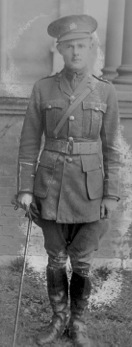
Capt. John Hannaford Symons was born in Toronto on 7th November, 1890, the son of William Limbery Symons (1860-1931) and Georgina Esther Lutz (1859-?). He received his early education at Trinity College School in Port Hope, Ontario, which he attended from September 1905 to the spring of 1908.
John Symons passed the entrance exam for the Royal Military College at Kingston in June 1908 (Militia Order No.137, dated 16th June, 1908, announced the results of the exam and Symons had been successful) and entered the college on 26th August as Gentleman Cadet No.795. While at RMC he achieved the rank of Lance Corporal and was for the most part slightly above average amongst his peers. He graduated on 22nd June, 1911, with very good conduct and character. His standing in his class was 14th out of 33.
After graduation Symons moved to Toronto to launch his career as an architect. He also began his service with the active militia, obtaining a commission with D Squadron of the Governor General's Body Guard (GGBG) effective 1st April, 1912. While serving with the GGBG Symons met and married E. Marion Douglas, and together they had a son, John William Symons, born on 4th February, 1914.
At the outbreak of war in August 1914, Lieutenant Symons answered the call to arms and attested for overseas service with the Canadian Expeditionary Force (CEF). He was eventually appointed as the Adjutant with the 4th Canadian Mounted Rifles, and deployed with his unit to France on 24th October, 1915. Lieutenant Symons performed his duties well throughout the bloody winter of 1915-16, earning a promotion to Captain. He also got on well with his fellow unit officers, especially his brother-in-law, Lieutenant J. Harvey Douglas.
Captain Symons was on duty at the battalion headquarters on the morning of 2nd June, 1916, ready to assist the unit OC, Lieutenant Colonel Ussher, as he entertained a visit from both the division commander (Mercer) and the brigade commander (Williams). At about 8.30am the enemy began a very heavy bombardment of the entire divisional front line, including all the ground in Maple Copse (I.23.g.9.2) and vicinity. Unfortunately, the Canadian mounted riflemen bore the brunt of this vicious attack. Before it was over, General Mercer was killed, and General Williams and Lieutenant Colonel Ussher were wounded.
The 4th CMR occupied trenches Nos. 47 to 53 inclusive. During the morning these trenches, such as they were, were crushed and completely overrun by the enemy. According to the 4th CMR's War Diary, after the attack began Symons was ordered by LCol Ussher to remain at the battalion headquarters, presumably to organize local defences, request immediate help, and keep communications open if possible. The German bombardment, however, made all this virtually impossible; at 9.15 am the following message was brought into the battalion HQ of 5th CMR by two lucky runners coming from the 4th CMR lines: "Our wires are cut, please have Corps Artillery turned on. General Mercer is here and wants it. General Williams has been hit." (sgd) J.H. Symonds Capt. & Adjt., 4th CMR. It was the last message he sent.
Having failed to turn up anywhere the following day, both Captain Symons and his brother-in-law Lieutenant J. Harvey Douglas were added to the rapidly growing list of missing 4th CMR officers and men. For Symons' wife, it must have come as a devastating blow to receive notice that both her husband and her brother were lost on the same day. Weeks passed without any word of their fate. Then months. Finally, almost a year later and having received no new information from any authority regarding his fate, for official purposes the CEF officially declared Captain Symons dead.
It would be learned much later still that Lieutenant Douglas had in fact survived that fateful day on Mount Sorrel, only to be taken prisoner by the Germans. Sadly, however, Captain John Hannaford Symons did not make it. His batman, No.109398 Cpl. Charles Hockley, who was also taken prisoner on 2nd June 1916, later confirmed in an interview with the Toronto Star conducted after his release from captivity in 1918 that he had personally witnessed the death of his officer. "The shell that killed Captain Symons", Hockley stated in his interview published 7th December, 1918, "blew me into a shell hole that was filled with water." When Hockley finally crawled out he discovered himself to be wounded, and was only saved from being bayoneted to death himself when a German officer intervened and had him sent back towards the enemy lines.
Symons' wife Marion and her family would spend more than a year trying to settle John's estate and recover the funds he had left in savings in England. Eventually, they would manage to recover the last of his personal effects. John's brother, Captain Harry Lutz Symons, survived the war.
Having transferred from the Canadian Engineers into the rapidly expanding Royal Flying Corps, Harry went on to fly Sopwith Camels with No.65 Sqn and ended the war as an ace with 6 victories. Working in the insurance business after the war, he penned the book 'Ojibway Melody' in 1944-45, which won the inaugural award of the Leacock Medal in 1947. Harry's son, Tom Symons, would serve as the first president of Trent University.
Symons' brother-in-law, Lieutenant J. Harvey Douglas, survived German captivity and later published a memoir of his wartime experiences. Simply titled, 'Captured: Sixteen Months as a Prisoner of War' (McClelland, Goodchild, & Stewart Ltd., Toronto, 1918).
Captain John Hannaford Symons, age 25, killed in action on 2nd June, 1916, during the 'Battle for Mount Sorrel', is remembered on several memorials including the RMCC memorial arch in Kingston, Ontario; the Royal Canadian Yacht Club Memorial in Toronto, Ontario; and on Tablet W, Panel 30 of the Menin Gate Memorial in Ieper, Belgium.
Biography with thanks to Andrew Godefroy.
Capt. Symons image credit Library & Archives Canada.
Menin Gate Tablet W, Panel 30 image supplied by 4cmr.com